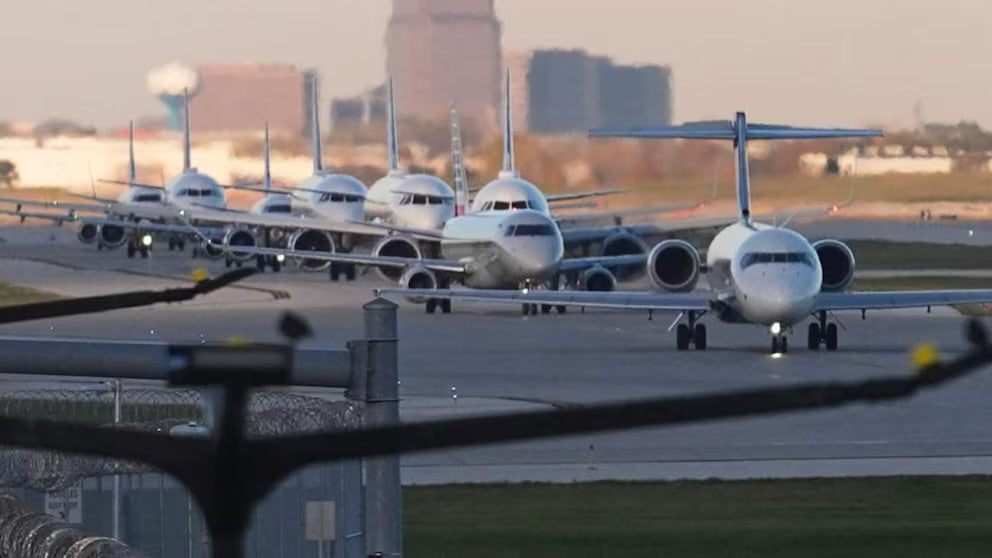In the shadow of a record-breaking federal government shutdown—now stretching into its 37th day as of November 6, 2025—the Federal Aviation Administration (FAA) is making unprecedented moves to safeguard the skies.
What began as a funding dispute between Congress and the White House has cascaded into flight reductions, staffing crises, and dire warnings of airspace closures. Airlines are scrambling, passengers are rebooking, and the nation’s travel arteries are constricting.
Yet, amid the chaos, a simple truth lingers: this could all end with a bipartisan continuing resolution (CR), restoring funds overnight. For essential workers holding the line, back pay awaits—making the whole ordeal feel less like necessity and more like high-stakes political theater.
The shutdown, triggered on October 1 when lawmakers failed to pass a full-year budget, has furloughed over 670,000 federal employees while forcing another 730,000 “essential” personnel to work without pay. Air traffic controllers, those unsung guardians of the skies, fall squarely into the latter category. Pre-shutdown, the FAA was already 3,500 controllers short of its targets, relying on mandatory overtime and six-day weeks to keep 44,000 daily flights aloft. Now, unpaid for over a month, fatigue is mounting. Controllers are dipping into savings, juggling second jobs, or simply calling out—leading to over 400 reported staffing shortages at FAA facilities, a quadrupling from last year. “We’re in new territory,” FAA Administrator Bryan Bedford admitted at a November 5 press conference, citing confidential safety data showing performance dips.
The fallout? Immediate cuts to airport operations. On Wednesday, Transportation Secretary Sean Duffy announced a 10% reduction in air traffic at 40 “high-volume” markets—think hubs like Atlanta’s Hartsfield-Jackson, Dallas-Fort Worth, New York’s JFK and LaGuardia, Chicago’s O’Hare, Los Angeles International, and even secondary spots like Indianapolis and Portland. Phased in starting Friday, November 7, the mandate requires airlines to slash schedules: 4% this weekend, ramping to the full 10% next week.
For context, O’Hare alone could see 121 of its 1,212 Friday flights axed if cuts are evenly distributed. United Airlines has already begun weekend cancellations, while American Airlines awaits FAA specifics on implementation. Since October 1, delays have snarled over 3.2 million travelers, with tens of thousands more flights impacted weekly.
These aren’t abstract numbers—they’re family reunions derailed, business deals postponed, and cargo shipments stalled, rippling into a projected 1-2% GDP hit if the impasse drags into December. The FAA isn’t shuttering runways outright, but by throttling arrivals and departures, it’s effectively “cutting airports” in capacity, prioritizing safety over volume. Flow control programs—temporary holds on takeoffs—have already choked airspace around Jacksonville Center and others due to understaffing. And the specter of worse looms: Duffy has repeatedly floated “shutting the whole airspace down” if shortages worsen, a scenario that could ground commercial aviation nationwide. National Transportation Safety Board Chair Jennifer Homendy called the cuts “the right thing to do,” but warned of building pressures as Thanksgiving approaches.
At its core, this crisis stems from lapsed appropriations, not malice—though the human toll is real. Essential FAA staff, like TSA screeners, must clock in despite empty bank accounts, buoyed only by the statutory promise of retroactive pay once Congress acts. Furloughed non-essentials, meanwhile, face indefinite limbo without that guarantee in some notices. Broader ripple effects compound the pain: SNAP benefits for 42 million Americans are partially stalled, Head Start programs for 750,000 kids are starving for funds, and national parks like St. Louis’s Gateway Arch swing between open and shuttered.
So why the stalemate? President Trump has dug in, urging Senate Republicans to nuke the filibuster for a unilateral funding fix—a nonstarter for most GOP senators—while dismissing Democratic calls for ACA subsidy extensions. Bipartisan talks on a “minibus” funding package show glimmers of progress, but hardliners on both sides keep the CR—a short-term spending bill—from passing. Critics, including Sen. Jerry Moran (R-KS), decry it as a “useless shutdown,” a performative standoff echoing the 2018-19 impasse that lasted 35 days. 12 With holiday travel peaking, the theater risks real tragedy: fatigued controllers guiding 3 million daily passengers through congested skies.
The FAA’s playbook—reduce, monitor, restrict—is a desperate bid for stability, not a blueprint for efficiency. Travelers, check apps like FlightAware for updates; airlines for rebooking waivers. Lawmakers, heed the delays at your local gates. A CR isn’t capitulation—it’s common sense. Until then, America’s wings are clipped, and the ground crew toils unpaid. The show must go on, but the curtain call can’t come soon enough.










Share:
China’s Bold Divorce Reform: A Victory for Private Property and Marital Stability
Musk’s Mandate: Tesla Shareholders Greenlight $1 Trillion Pay Package, Cementing Capitalism’s Boldest Bet